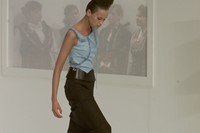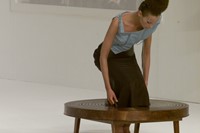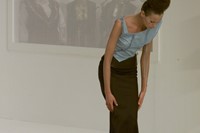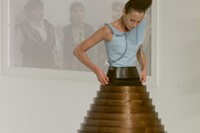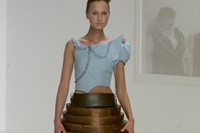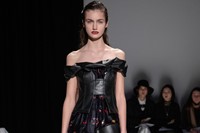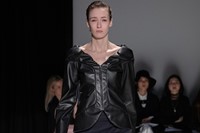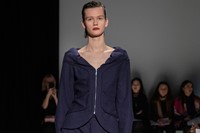In the wake of his 25th anniversary show, we look back at some of the designer’s most memorable runway moments
During preparations for the collection that would mark the 25th anniversary of Hussein Chalayan’s label, the designer found his mind returning to an unlikely title: Pre-Tension. In the vernacular, pretension is a word associated with empty posturing, or misguided ambition that is greater than any actual skill. It certainly isn’t the first word that comes to mind when considering a celebration of Chalayan’s quarter century, in which time he has produced some of the most technically accomplished clothes on the market.
But as the writer Dan Fox writes in his book Pretentiousness: Why It Matters, perhaps we have its meaning all wrong. Fox notes that pretentiousness is woven into the very fabric of the greatest art, or in this case, fashion: it’s an attempt to outstrip what has come before, or achieve something previously beyond the artist’s capabilities. Dismissing something as pretentious says more about the speaker than it does the artist: at the end of the day, it’s better to try to push the boundaries and fail than to not try at all.
And there are few designers who have pushed the boundaries as relentlessly as Hussein Chalayan. Emerging with a graduate collection made from fabrics he had buried underground to oxidise over a two month period, his designs were immediately snapped up by Browns, while his rigorous craftsmanship (along with the avant-garde spectacle of his shows) has earned him a reputation as one of fashion’s greatest alchemists, producing collections as dazzling as they are desirable.
Looking back across 25 years in the business, we round up Chalayan’s most striking runway moments and the groundbreaking designs they showcased, from shape-shifting robot dresses to outfits glittering with LED screens. It’s further proof – if you needed it – that a little bit of pretension can go a very long way.
When Chalayan transformed an airplane wing into a couture gown
Presented on the stage of London’s premier dance venue, Sadler’s Wells – a location that he returned to for yesterday’s anniversary show – Chalayan’s Spring/Summer 2000 collection began with models in simple, meticulously cut dresses against a stark white backdrop designed by his longtime collaborator, set designer Alexandre de Betak. But by the end of the show, one of the designer’s most memorable forays into the world of technology would receive its debut: the airplane dress. Initially an architectural, Balenciaga-style structure of fibreglass and resin, a young boy walked on stage pointing a remote control at the dress, triggering it to fold up like a blossoming flower and reveal a mass of powder pink tulle underneath the airplane wing shell. Chalayan is perhaps best understood as a designer of paradoxes, balancing the wildly innovative with the immediately wearable. There are few garments that capture this tangle of contradictions better than the airplane dress, where sci-fi glamour gave way to unabashed romance – all thanks to a touch of engineering wizardry.
The time he made dresses that doubled up as living room furniture
Just a season later, Chalayan would again create another shapeshifting gown that defied belief: this time a coffee table that, in a masterstroke of industrial design, transformed into a wooden hooped skirt. Beginning with a set that resembled a standard domestic interior – albeit with Chalayan’s trademark whitewashed walls – four mid-century modern chairs and the previously mentioned coffee table were covered with decorative objects and knick-knacks. As the models weaved around the furniture, they began removing the objects one by one, until four models emerged in grey shift dresses and swiped the covers off the chairs and wore them, before finally folding the chairs up into suitcases and leaving the stage almost bare. Then came the pièce de résistance: stepping into the centre of the coffee table, the model pulled at the telescopic rings and attached it to her waist, before leaving with that too. Like all of Chalayan’s shows, the message was purposefully cryptic. Whether it was a meditation on the precariousness of urban living in the 21st century, or a critique of disposable fashion – a problem that still plagues the industry 15 years on – the designer’s surrealistic vision of a self-destructing home came to be one of his most famous moments.
When he took viewers on a journey through fashion history with a single dress
Chalayan had already experimented with garments that could shapeshift with the touch of a button: what if he could create a dress that could not only move of its own accord, but also transform from a Victorian corset to a Roaring 20s flapper number, or a 1950s New Look skirt to a mod-inspired shift dress, in a matter of seconds? For his Spring/Summer 2007 collection, he did just that: with a series of six mechanised dresses, Chalayan took the show’s attendees on a whistle-stop tour through 20th-century fashion history, culminating in a long stream of more wearable looks that echoed the silhouettes articulated by the moving gowns. “I wanted to prove that my approach is nothing to be frightened of, that people can wear these things,” he told Vogue at the time. It’s this unrivalled ability to balance high concept clothing with beautifully cut staples that has secured Chalayan’s longevity: initially considering training as an architect or a sculptor, his intimate knowledge of how the human form relates to the space surrounding it is just as relevant when designing a show-stopping conversation piece as it is a sharp piece of tailoring for the workplace.
How he used light-up dresses to communicate an environmental message
At the beginning of Chalayan’s Autumn/Winter 2007 collection, the lights went out to the sound of thunder rolling in the rafters, before a model emerged from the darkness in a dress that twinkled with the light of 15,400 LEDs, reflected and refracted by Swarowski crystals. Displaying both the strict grid of an aerial cityscape and a series of moving abstract motifs that represented the advent of spring, it wasn’t just the garment’s technological complexity that led the gathered editors and buyers to take a sharp intake of breath, but also its thoughtful message on the relationship between man and machine. Chalayan has made no secret of his long-held disdain for the fashion industry’s inherent wastefulness, while also acknowledging his complicity in the problem as a designer: just last week, in an interview with The New York Times, he described the relentless pace of the industry treadmill as crippling the creativity of many of his fellow designers. With his LED dresses, he offered an intensely cerebral solution, with the blank canvas of a white dress acting as a backdrop for whichever outfit you want to cast onto the screen that day – what could possibly be wasteful about owning one garment that can transform into endless others? Even if it’s hardly the most practical solution (we can assume the dresses are strictly dry clean only) it’s impossible not to get swept away by Chalayan’s fantastical vision of an eco-friendly future.
The designer’s 25th anniversary show, which looked to his past and future
Chalayan might not be a designer to rest on his laurels, but for yesterday’s anniversary show he at least allowed himself a moment of nostalgia: as guests filed into the characteristically minimalist space, projections covered the walls with highlights from some of the designer’s most eye-popping runway moments. Those expecting a full-blown Chalayan extravaganza, however, were in for a surprise: despite returning to the theatrical surroundings of Sadler’s Wells, the show was a tribute to the loyal customer base who have followed him through the ups and downs of his 25-year career. There were luxurious coats and separates in midnight blue and burgundy, striped knits that morphed from batwing tops to cinched dresses, and a well-judged dose of humour with the headpieces that resembled the flamboyant poses of voguing hands.
But that isn’t to say he didn’t have one or two more ambitious tricks up his sleeve. As the show concluded, a trio of Japanese bunkaru puppeteers guided the folds of draped fabric trailing from the final three dresses to spell a series of Japanese letters that read ‘to be’. In place of the enigmatic technical sorcery we’ve come to expect from his shows, it seems he turned to something altogether more simple – a medium of artistic expression steeped in tradition, neatly underlining Chalayan’s dual role as both conjurer of dreams and humble costumier. It was a carefully considered reminder that even if Chalayan is more widely known for eye-popping spectacle, his longevity is thanks to the loyal customers that return to him again and again for his inventive, architectural tailoring and impeccably cut gowns. You can’t put a price on that.

